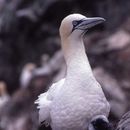Biology
(
Inglês
)
fornecido por Arkive
Gannets feed on pelagic shoaling fish, such as mackerel and herring (6), and when fishing, often execute breathtaking plunge-dives from considerable heights, splashing into the sea with the wings folded back (2).
The breeding colonies, known as gannetries, are occupied from March to September (8). The nests are tightly packed together, and roaming chicks or adults who land in the wrong location are often fiercely attacked (9). Courtship involves ritualised preening, bowing and head-pointing (9), and nesting commences in April (9). The mound nest consists of seaweed, feathers and plant material, and extra seaweed may be incorporated into the nest during incubation of the pale blue, chalky egg (7), which is laid in late April or May (9). A clutch typically consists of just one egg, although two may occasionally be produced. Incubation takes between 43 and 45 days (7), and is carried out by both parents, by placing their feet on the egg (9). After fledging, most juveniles migrate to the south during August and September (6); they do not attain full adult plumage until 5 years of age (6).
Conservation
(
Inglês
)
fornecido por Arkive
A number of the internationally important British breeding colonies occur within RSPB reserves, furthermore 98 % of the British breeding population (equivalent to 75% of the world population) occurs within Special Protection Areas (SPAs) (8).
Description
(
Inglês
)
fornecido por Arkive
The gannet is a magnificent large seabird, with long narrow wings, a long neck, and instantly recognisable plumage. Adults are white with black tips to the wings and a yellowish head, which fades somewhat in winter (2). There is a ring of bluish skin around the eyes, which explains the alternative name of 'spectacled goose' (3). Males and females are similar in appearance, but females have green lines on the toes whereas in males these are more yellowish (4). Juveniles are greyish-brown in colour with white freckling (2), which increases with age until the full white plumage is reached (11). A variety of loud vocalisations are produced in breeding colonies (2).
Habitat
(
Inglês
)
fornecido por Arkive
This seabird usually breeds on uninhabited islands, but occasionally on mainland cliffs (8).
Range
(
Inglês
)
fornecido por Arkive
Britain supports internationally important numbers of gannets (5); at present the British breeding population represents 60-70% of the world total (8). Most nest on Scottish offshore islands, there is also one colony on the east coast of England at Bempton Cliffs, and one on Grassholm, off southwest Wales (8). In winter the breeding adults disperse in home waters, and can be seen from most parts of the British coastline, although a minority migrate to warmer areas, as do most of the young (6); these individuals can reach as far south as West Africa and the western Mediterranean (2). Globally, gannets are restricted to the North Atlantic, most breeding colonies are in the East Atlantic, including Britain, Ireland, France, Iceland, Norway and the Faeroe Islands, but there are also colonies in Newfoundland and Quebec (8).
Status
(
Inglês
)
fornecido por Arkive
Receives general protection under the Wildlife and Countryside Act 1981 (8). Included in the Birds of Conservation Concern Amber List (medium conservation concern) (10).
Threats
(
Inglês
)
fornecido por Arkive
The gannet is not threatened at present, but is increasing in numbers. Large chicks were harvested at a number of sites in the past; this practice continues to the present day in a traditional hunt at one site in Scotland (8).

